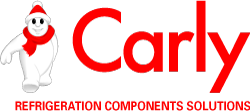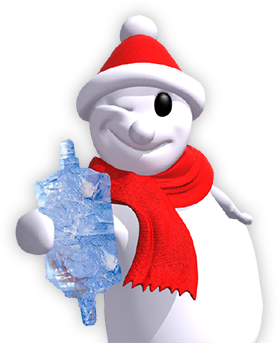The reversible installation and particularly the heat-pumps are often subject of pollution,principally due to moisture in the circuit.
Presence of moisture in a refrigerating installation generate the decomposition of the refrigerant and oil.
It causes the formation of organic acids which can create:
– The circuit corrosion
– The deterioration of the motor’s windings
– The formation of sludge
– The compressor’s destruction
In the case of compressor’s carbonization, and after its replacement, it is not sufficient to change the polluted refrigerant.
Indeed, in such a case, it remains inevitably in the refrigerating circuit some acid oil and some residues which have not been evacuated.
To resolve such problems, CARLY recommends two types of actions:
– a preventive method is to install a bi-flow filter drier, DDCY, and a sight glass, VCYL which allows to control the DDCY efficiency on the liquid line before the startup of the installation.
– a curative method is to install a cleaning bi-flow filter drier, DDNCY, on the liquid line when the presence of acidity is detected or when a compressor broke down.
Setting up a cleaning bi-flow filter drier DDNCY enable to treat both fluid and oil, while maintaining the refrigerant in the installation.
This cleaning operation can thus be realized without creating a prolonged stopping of the heat pump.
It can be initiated in any season since the cleaning filter DDNCY is designed to function in 2 direction of the circulation.
It is no longer necessary to restrain the operation of the heat pump in a hot or cold mode to carry out the cleaning of both refrigerant and oil.
The control of effectiveness of the depollution is done by sampling and analysis of the oil, using TESTOIL-MAS or TESTOIL-POE in order to check its acidity.
To increase the rapidity of the refrigerant cleanup, CARLY recommends the installation of a suction filter drier FNCY (burn-out, single flow), between de 4-ways valve and the suction of the compressor.
With the CARLY DDNCY filter, the refrigerant will be filtered and cleaned up before being directed to the expansion valves and the evaporators, and thanks to the CARLY FNCY filter, it will be filtered and cleaned up before getting into the compressor.
Attention:
The DDNCY and FNCY are for temporary use only.
In order to avoid a pressure drop which can decrease the efficiency of the installation, it is absolutely necessary to replace them after the cleaning operation.
The DDNCY will be replaced by a bi-flow filter drier DDCY equivalent in size (for example a DDNCY 164 will be replaced by a DDCY 164), and the FNCY will be replaced by a cleaning filter FACY equivalent in size. (for example a FNCY 285 will be replaced by a FACY 285)










